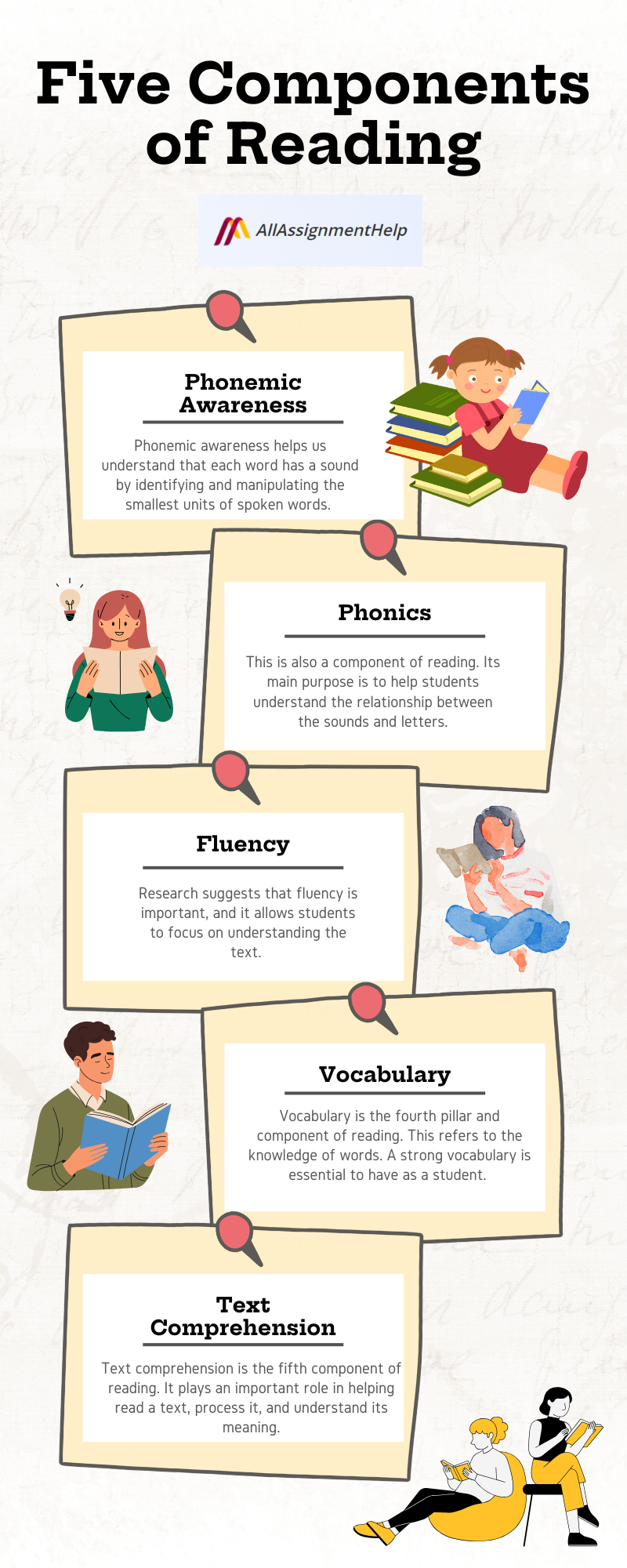Table of Contents
How to make students read is one of the major concerns of almost all educators. Reading has many benefits, like improving concentration and enhancing memory, among others. However, students don’t really understand this. Getting students to read is often a challenging task. Many reports have suggested that neither schools nor colleges are even interested in reading. Though it is essential for academic success, students never really enjoy reading. Keeping this in mind, five components of reading were introduced by the National Reading Panel (NRP) in the United States. The main purpose of these components is to boost literacy and close reading gaps.
Are you a teacher wondering how to help learners develop the skills they need to become proficient readers? In this blog post from the experts of All Assignment Help, we have discussed the five components of reading. These pillars are essential for reading proficiency and can help children become strong readers.
What Are the Components of Reading?

Phonemic Awareness
“Phonemic awareness” is one of the components of reading. It focuses on phonemes, which are known as sounds. Phonemic awareness helps us understand that each word has a sound by identifying and manipulating the smallest units of spoken words. This component of reading is all about hearing the sound of the word. It does not usually involve the use of written letters.
Example of Phonemic Awareness
Let’s take two words, “mother” and “brother.” These two words are commonly pronounced as “MUH-ther” and “BRUH-ther.”
Let us now look at phonemes in these words.
- Mother— Here, there are four phonemes: ‘m,’ ‘uh-o,’ ‘th,’ and ‘er.’
- Brother— Here, there are five phonemes: ‘b’, ‘r’, ‘uh-o’, ‘th’, and ‘er’.
Phonemic awareness helps us understand the sounds used in words. It is the ability to recognize the individual sounds in a word.
Importance of Phonemic Awareness to Students
- It helps in predicting children’s ability to read.
- It makes reading and spelling words easier.
- It prevents later reading difficulties.
- Spelling words correctly enables the writing development of students.
- It improves students’ comprehension.
How Teachers Can Teach Phonemic Awareness
Decoding words is one of the common issues faced by students, which reduces students’ understanding of text. If left untreated, this can impact students’ academic growth. In many cases, students even consider inquiring, can someone do my online class? Poor recognition of words makes it difficult to complete assignments and other coursework on time. This might make students look for online class helpers for their assistance.
As a teacher, it is your responsibility to build phonemic awareness among students. You can use fun and engaging activities to help students better understand their academic concepts. Here is how you can teach phonemic awareness to students.
- Focus on oral activities that require no use of letters.
- Teach blending and segmentation, which will improve their reading skills.
- Let them play with sounds using songs and rhythms.
- One-on-one attention is essential; therefore, provide individual support to each student.
Phonics
What is phonics? Phonics refers to connecting letters to sounds. This is also a component of reading. Its main purpose is to help students understand the relationship between the sounds and letters. With the help of phonics, one will know the relationship between letters and sounds and represent those in writing.
Students who are new to the English language might struggle to understand these concepts and their relationship with each other. However, with regular support and guidance, they can overcome this difficulty. Phonics is an important part of reading. However, reading does not solely depend on it. One no longer needs to guess and memorize words. With the right knowledge of phonics, one can easily decode even the unfamiliar words.
Also Read: How to Enhance Reading: A Step-By-Step Guide for Students
Examples of Phonics
We hope the meaning of phonics is clear to you. Blends, digraphs, and vowel teams are some of the phonic patterns. We have provided an example to help in better understanding.
- “Mat”—Here, the first letter is “m” and helps in creating an “mm” sound.
- “Ship”—Here, the first letter is “sh” and helps in creating a “sh” sound.
- “Light”—Here, the middle letter is “igh.” igh makes the (long i) sound.
Practical Tips to Teach Phonics to Students
- Start by focusing on the letters that occur frequently. This will help in better blending of words and sounds.
- Help them understand how sounds come together.
- Use multisensory techniques to engage multiple senses.
- Phonic games can reinforce sound-letter relationships.
Fluency
What does fluency refer to? It is the ability to smoothly read a text with proper accuracy. Not all students are fluent in reading, and it is one of the major concerns of teachers. Only a few of them know how to maintain an appropriate speed while reading and to maintain proper expression. While the rest just struggle to recognize the gap between words.
Research suggests that fluency is important, and it allows students to focus on understanding the text. The student who reads properly word-for-word understands the overall meaning of what they read. Such students have a better chance of grasping their academic concepts. They are likely to submit their assignments without looking for others for assignment help.
Examples of Fluency
- What are you doing? Reading it without any expression is of no use. Here you are asking something from someone, so there should be an expression of a question mark.) (The correct way to read it is, What are you doing? This will convey the proper meaning, and the reader will understand that you are asking something.)
- Once upon a time, my family and I lived in a big villa. This is the correct form to read this sentence. (Let’s suppose someone is reading it as Once…upon…a…time…me…and…my…family…lived…in…a…big…villa.) (How does it sound? Confusing, right? When reading, it is essential to know when to pause and continue to make the phrase sound natural.)
How Teachers Can Improve the Reading Fluency of Students
- Ask them to read aloud and point out their mistakes. Educate them about proper pacing, phrasing, and expression.
- Let them reread a passage two or three times. It will help them understand their mistakes and build confidence in learning.
- Pair a group of students, as nothing can beat peer support. Group reading is the most effective way to improve the fluency of students.
- Self-monitor each student and help them with tricky sentences.
Also Read: Importance of Editing and Proofreading in Your Online Thesis Papers
Vocabulary
Vocabulary is the fourth pillar and component of reading. This refers to the knowledge of words. A strong vocabulary is essential to have as a student. This can help them express themselves clearly. Reading is incomplete without a proper understanding of vocabulary. To effectively read and understand, you need to know what the words used are.
We are all aware of the words from our childhood, as they are an important part of communication. However, vocabulary development is something that is built in later stages of life. Teachers play an important role in improving vocabulary knowledge. Once they start understanding what they read, everything will start making sense. You might no longer need to struggle with limited vocabulary.
Oral vocabulary and reading vocabulary are the two types of it. Speaking and listening are an oral vocabulary; recognizing and understanding refer to the reading vocabulary. Oral vocabulary is useful for beginners. It helps them identify the word and understand it.
Examples of Vocabulary
Here are some examples of vocabulary for students.
- Basic vocabulary for basic learners: “read,” “draw,” “sing,” “bat,” “red,” “blue”
- Everyday functional vocabularies: “book,” “pencil,” “desk,” “school,” “college,” “break,” “address,” “phone,” “internet”
- Academic vocabulary: “analyze,” “describe,” “explain,” “detect,” “contrast,” “establish,” “estimate,” “classify,” “demonstrate,” and “facilitate.”
Also Read: A Comprehensive Guide To Mastering The Art of Reading A Textbook?
Text Comprehension
Text comprehension is the fifth component of reading. As a teacher, you might often ask your student to read, process, and understand its meaning. Text comprehension is the one that helps in this process. It plays an important role in helping read a text, process it, and understand its meaning.
This is an important pillar of reading with which students will start making sense of every word. You can decode all vocabulary and start processing everything you read. Literal, inferential, and evaluative are the three parts of text comprehension.
Importance of Text Comprehension to Students
- It helps students analyze information.
- Text comprehension helps students effectively grasp their academic concepts.
- It improves the vocabulary and language skills of students.
- This can encourage lifelong learning. Students can learn independently throughout life.
Frequently Asked Questions
Question 1: What are the 5 components of reading?
Answer: Phonemic awareness, phonics, fluency, vocabulary, and text comprehension are the five components of reading.
Question 2: What is the science of reading?
Answer: It refers to the individual’s ability to read and how they understand a given instruction. This helps in early literacy instruction.
Question 3: What are the different types of reading?
Answer: Skimming, scanning, intensive, and analytical reading are the four types of it.
